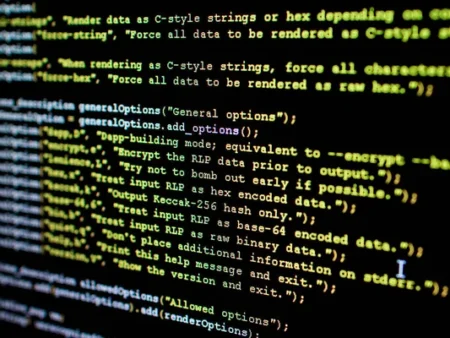Understanding Blockchain: A Groundbreaking Digital Revolution
Unveiling Blockchain Technology: A Comprehensive Guide
Understanding the Basics: What is Blockchain Technology?
Blockchain technology represents a revolutionary shift in how data is stored and transferred. At its core, a blockchain is a distributed ledger that records transactions across multiple computers in such a way that the registered transactions cannot be altered retroactively. This decentralized nature of blockchain ensures that all parties in a network have access to the same information, providing transparency and accountability.
Each block in a blockchain contains a list of transactions. Once a block reaches its capacity, it is linked to the previously completed block, forming a chain — hence the name “blockchain.” This structure allows for the secure and efficient processing of transactions, as every change must be validated by a consensus mechanism, typically involving multiple network participants. The essence of blockchain lies in its ability to facilitate trust among strangers in a digital environment.
Different types of blockchains exist, including public, private, and consortium blockchains. Public blockchains, like Bitcoin and Ethereum, are open to anyone and are maintained by a global community of users. Private blockchains are restricted to specific users and are commonly used by organizations for internal purposes. Consortium blockchains sit between the two, allowing a group of organizations to manage a blockchain collaboratively.
Understanding blockchain requires familiarity with key concepts such as nodes, miners, and smart contracts. Nodes are individual computers that maintain copies of the blockchain, while miners are participants who validate transactions and add new blocks to the chain. Smart contracts are programmable agreements encoded into the blockchain that execute automatically when predefined conditions are met.
Key Features of Blockchain: Decentralization and Security
Decentralization is perhaps the most pivotal characteristic of blockchain technology. Unlike traditional databases controlled by a single entity, blockchains distribute data across a network of nodes. This distribution eliminates the risk of a single point of failure and allows for greater resilience against data breaches or malicious attacks, as there is no central control to target.
Security is another fundamental feature of blockchain. Each transaction is encrypted and linked to the previous transaction, creating a chain of blocks that is nearly impossible to alter without the consensus of the majority of participants in the network. This characteristic significantly reduces the risk of fraud and ensures the integrity of the data recorded.
The consensus mechanism is vital to maintaining security and trust within the blockchain. Different consensus models, such as Proof of Work (PoW) and Proof of Stake (PoS), determine how transactions are verified. PoW requires participants to solve complex mathematical problems to validate transactions, making it resource-intensive but secure. Conversely, PoS allows validators to create new blocks based on the number of coins they hold, promoting energy efficiency.
To illustrate these features, consider the following comparison of traditional databases and blockchain:
| Feature | Traditional Database | Blockchain |
|---|---|---|
| Control | Centralized | Decentralized |
| Data Integrity | Vulnerable to tampering | Immutable and cryptographically secure |
| Transaction Speed | Fast (depending on the system) | Slower (due to consensus) |
| Trust | Requires a trusted third party | Trustless — relies on consensus |
Real-World Applications: Beyond Cryptocurrency Transactions
While Bitcoin and other cryptocurrencies are the most recognized applications of blockchain, its potential extends far beyond digital currency. One prominent application is supply chain management, where blockchain can enhance transparency and traceability. By recording every step of a product’s journey on a blockchain, companies can easily track origin, authenticity, and any changes made throughout the supply chain.
Additionally, blockchain technology is applied in the field of healthcare for managing patient records. By creating a secure, decentralized system for storing health data, patients can have greater control over their information while allowing healthcare providers to access verified records seamlessly. This approach improves data accuracy, reduces administrative costs, and enhances the overall quality of care.
Another significant application of blockchain technology is in voting systems. By using blockchain for elections, the voter registration process can be streamlined, and the integrity of votes can be ensured. Voters can cast their ballots via secure digital platforms while maintaining anonymity, reducing the risks of fraud and enabling a more transparent electoral process.
In the entertainment industry, blockchain is transforming how artists and creators monetize their work. Through the use of smart contracts, artists can sell their music or art directly to consumers, receiving fair compensation without intermediaries. This innovation empowers creators, allowing them to retain ownership and control over their intellectual property while fostering direct relationships with their audience.
Challenges Facing Blockchain Adoption in Various Industries
Despite its potential, the adoption of blockchain technology faces several significant challenges. One primary concern is scalability. As more users join a blockchain network, the time required to validate transactions can increase dramatically. For instance, Bitcoin’s network can handle only a limited number of transactions per second compared to traditional payment systems like Visa, which processes thousands.
Regulatory uncertainty is another hurdle for blockchain adoption. Governments worldwide are still formulating regulations that govern the use of cryptocurrencies and blockchain applications. This uncertainty can deter investment and innovation, as businesses may be hesitant to adopt technologies that could later face restrictions or prohibitions.
Interoperability between different blockchain systems also poses a challenge. Many existing blockchains operate in isolation, making it difficult to transfer data or assets between them. For blockchain technology to fulfill its promise of a connected digital economy, solutions that facilitate interoperability and standardization across networks are essential.
Moreover, public perception and understanding of blockchain technology are still developing. Many individuals and organizations remain skeptical about its benefits, often associating it solely with cryptocurrency scams or failures. Educating stakeholders on the legitimate use cases and advantages of blockchain is crucial for fostering broader acceptance and investment.

The Future of Blockchain: Trends and Emerging Innovations
As blockchain technology continues to evolve, several trends are emerging that may significantly impact its future. One notable trend is the rise of decentralized finance (DeFi). DeFi applications are disrupting traditional financial systems by providing users with access to loans, trading, and investing services without intermediaries, thereby enhancing financial inclusion and democratizing access to capital.
Another trend is the growing interest in non-fungible tokens (NFTs). NFTs are unique digital assets that represent ownership of specific items, such as art, music, or virtual real estate. This innovation enables creators to monetize their work in novel ways while providing buyers with verifiable ownership, transforming the landscape of art and entertainment.
The integration of blockchain with other emerging technologies, such as artificial intelligence (AI) and the Internet of Things (IoT), is also gaining momentum. Combining these technologies can lead to more efficient data management and automated systems. For example, IoT devices could use blockchain to securely transmit data, while AI could analyze that data for actionable insights, creating smarter systems across various industries.
Lastly, the focus on sustainability and energy-efficient blockchain solutions is increasing. Many projects are exploring alternatives to energy-intensive consensus mechanisms, such as PoW, in favor of PoS and other less resource-demanding models. This shift is crucial for addressing environmental concerns associated with blockchain technology and ensuring its long-term viability.
Conclusion: Embracing Blockchain for a Digital Tomorrow
In conclusion, blockchain technology holds the promise of transforming various sectors by providing enhanced security, transparency, and efficiency. While challenges remain, the potential applications of blockchain go far beyond cryptocurrency, impacting industries such as healthcare, supply chain management, and finance. As organizations begin to recognize the value of decentralized systems, the adoption of blockchain is likely to accelerate.
The future of blockchain is bright, with emerging trends and innovations paving the way for even greater advancements. By harnessing the power of blockchain, we can create a more secure and equitable digital world that empowers individuals and fosters trust among participants in various ecosystems.
Embracing blockchain technology is not merely a trend; it is an essential step towards building a digital tomorrow. As we navigate this transformative landscape, stakeholders across industries must collaborate to overcome challenges and unlock the full potential of blockchain for future generations.










Clear explanation. Blockchain is the future!
Great article! Blockchain sounds amazing.
Easy to understand. Blockchain is cool!
Nice article! Blockchain can do so much.
Wow! Blockchain can help in many fields.
Very helpful! Now I get blockchain better.
Awesome post! Blockchain has many benefits.
Interesting read. Blockchain is powerful.
Good info on blockchain and its uses.
I like how blockchain is secure and safe.